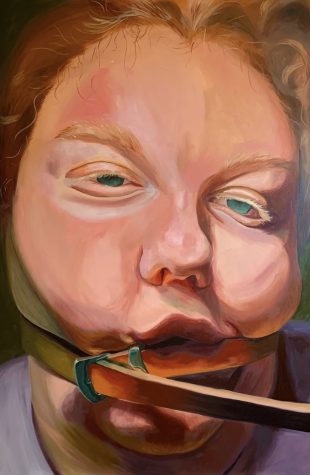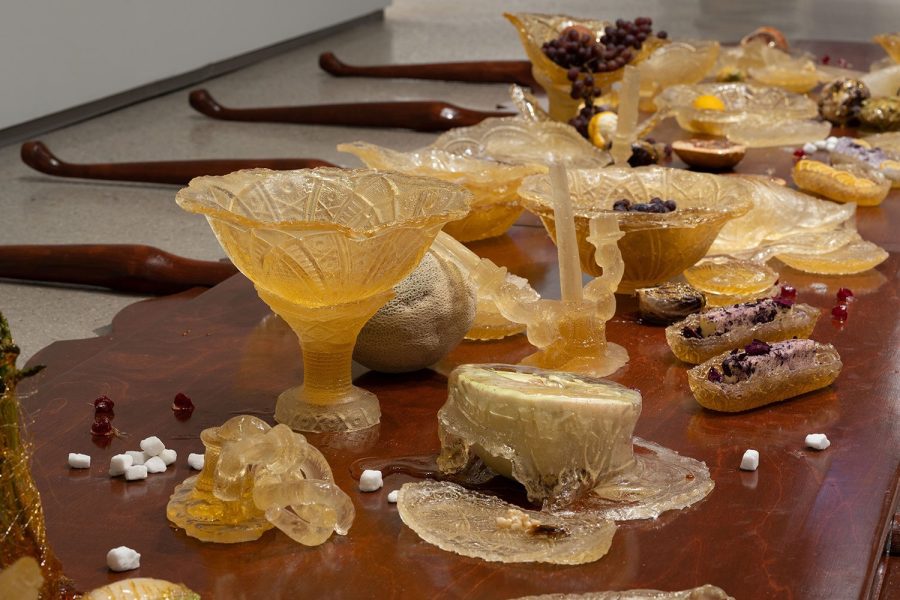Southside Art exhibit centers the fat experience, confronts anti-fat bias
Image courtesy of Natalie Sweet
An art piece titled “Triomphe de la graisse” by Katie Rauth on display at Soma Grossa in the Southside.
January 17, 2023
The name of a Southside art exhibit, “Soma Grossa” translates to “gross body” in Latin. It may sound harsh, but “Soma Grossa” didn’t sweeten the experience, according to curator Anne Mirzayan.
“Soma Grossa” is an exhibit that ran through Saturday at the Brew House Association in South Side. It explored fatness through a critical lens, and fat artists pulled their life experiences into a wide range of mediums, including painting, photography, jewelry, video projection and large-scale installations, such as sculpture.
Mirzayan said in a press release that the exhibit exposed the “ruthless calculus” society subjects fat bodies to 一 value equals space. In both the art world and the real world, people tend to tell fat individuals they take up too much space to deserve respect.
“Bringing in fat artists whose work explicitly displays fat bodies allows these communities to take charge of a narrative that usually belittles, demonizes and dismisses them,” Mirzayan said. “It pushes the margins of what audiences are comfortable with in order to get them to think critically about anti-fat bias and how it manifests in their daily lives.”
In an article she wrote for online publication HyperAllergic, Mirzayan said she believes discussion of fatness in art skips out on a critical lens in favor of surface level body positivity, or a freak show-esque morbid fascination.
“You condemn us for what you’re sure is rampant gluttony, yet jump at the chance to devour us whole,” Mirzayan said. “The art world is no exception. When I was researching for this exhibition, results were sparse. Shows featuring fat bodies exist, sure, but shows centering fatness in a critical way?”
In “Soma Grossa” artist Sophie Pearson’s paintings, she examines the actual fat on the body from different contorted angles. In one piece, “Belted,” the viewer stares at a woman with a belt tied around her face, causing her flesh to bunch up.

Like many artists in the exhibit, Pearson asks not for pleasantries and praise. Instead, she evokes discomfort to drive conversations about fatphobia and body representation in art.
Natalie Sweet, the founder and executive director of Brew House Association’s program for emerging curators, “Perspectus,” expressed that in her opinion, the exhibit’s profound impact is clear.
“It’s given opportunities for people to have those dialogues and really feel seen,” Sweet said. “It’s been a really thought provoking experience for people to come see the show, especially some people who have read about it [fat activism], maybe seen some headlines, to come and view the work.”
These conversations haven’t stayed within the exhibit — they’ve mobilized the community in practicing fat acceptance and kindness. The Brew House Association collaborated with All Bodies Welcome Yoga and Pittsburgh Fatties Social Club to host an All Bodies Welcome Yoga and Art event on the morning of the last day of the exhibit on Saturday.
The first half of the event featured a 45-minute class from All Bodies Welcome Yoga, called “Yoga For Larger Bodies,” in which instructors prioritize accessibility and accommodation to create a safe and open space for all individuals, regardless of size. An optional 45-minute tour of the “Soma Grossa” exhibit took up the second half of the event.
Emily Anderson, the owner of All Bodies Welcome Yoga, said she felt that attendees cherished seeing how body acceptance and fatphobia presents in both art and movement.
“‘Soma Grossa’ was an amazing setting for an inclusive yoga class. ‘Soma Grossa’ furthers conversations about fat people defining and celebrating their experiences,” Anderson said. “The attendees loved practicing yoga in a safe, supportive community of like-minded and like-bodied students.”
During the tour section of the event, artist Sophie Pearson’s work provoked conversations about the either cruel or non-existent representation of fatness in art. Pearson’s work paints the fat body from close angles to move away from the archetypal, non-fat body that art education uses. In just the simple conversation started from Pearson’s work that morning, art attendees and directors challenged the “archetype” of non-fat bodies.
Sweet recalls Pearson telling curator Myrzyan that in art school, the model of learning how to paint the human body was always non-fat and nothing like Pearson’s own.
“[Pearson] was saying, ‘We had been really taught to look at non-fat bodies as a way of learning to draw the body… I thought this isn’t really relevant to me — How can I use my own body as an opportunity to understand how to paint fat bodies?’”








